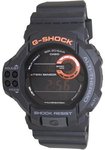Like any G-Shock but with an added barometer, thermometer and altimeter. Cheapest I've found elsewhere is AU$123 domestically or ~AU$110 from overseas.
Perfect for the person that can’t get enough technology, this watch will keep you looking great, while keeping you punctual, provided you don’t lose track of time fiddling with this watch’s nifty alti-thermo. In addition to this cool feature, this timepiece features an alarm, timer, light, and water resistance to 200 meters. Plus with its 51mm black plastic case and black plastic band, this watch proves to be more than just an ordinary sport watch.


Additional 10% off with coupons don't seem to work but there's links through savings.com which supposedly give you free shipping. I already bought so can't confirm.